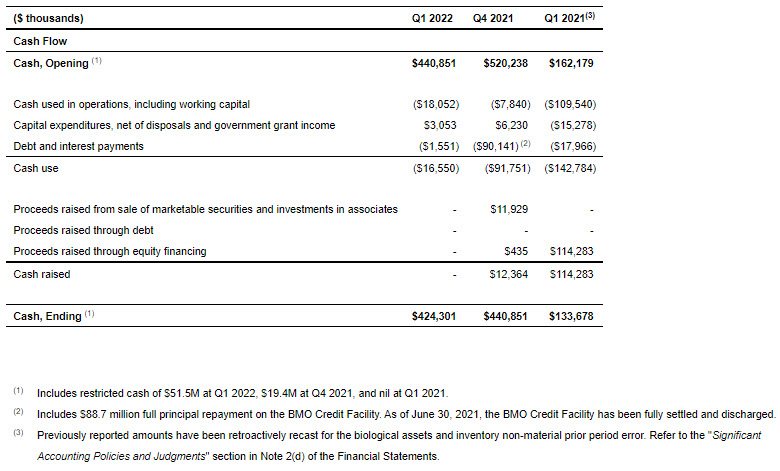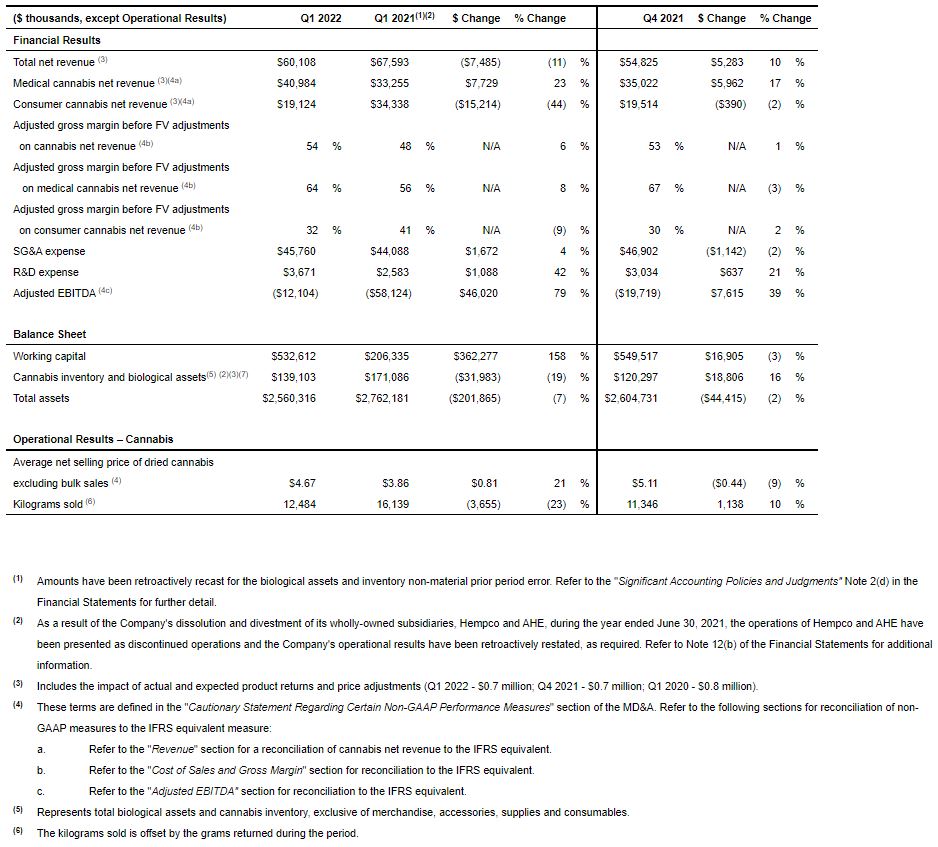
Aurora Cannabis Announces Fiscal 2022 First Quarter Results
- Transformation Plan On Track; Actions Taken-to-Date Have Driven Over $33 Million in Annualized Run-Rate Cost Savings
- Total Cannabis Net Revenue, Net of Provisions, Grew ~10% to $60.1 million Compared to $54.8 Million in Q4 2021
- Adjusted EBITDA Excluding Restructuring Costs Improved by $4.0 million to a loss of $11.5 million versus Q4 2021; Clear Pathway to Adjusted EBITDA Profitability by H1/FY23
- Improved Adjusted Gross Margin before FVA of 54% versus 53% in Q4 2021
EDMONTON, AB, Nov. 9, 2021 /CNW/ – Aurora Cannabis Inc. (the “Company” or “Aurora”) (NASDAQ: ACB) (TSX: ACB), the Canadian company defining the future of cannabinoids worldwide, today announced its financial and operational results for the first quarter fiscal 2022 ended September 30, 2021.
“Our transformation plan is on track. We continue to strengthen and transform our business while benefitting from broad diversification across our international medical, domestic medical, and adult recreational segments. On a run-rate basis to date, we have executed over $33 million in annualized cost savings and are positioned to deliver approximately $60 to $80 million in aggregate across selling, general and administrative (“SG&A”), production, facility and logistic expenses upon the completion of our business transformation. Our strong Adjusted gross margins and narrowing Adjusted EBITDA loss are also providing us with a clear path to profitability by the first half of fiscal 2023 as we position ourselves for long-term success. Importantly, our robust balance sheet and working capital support our organic growth plans, and provide us with the financial flexibility to evaluate accretive M&A opportunities,” stated Miguel Martin, Chief Executive Officer of Aurora Cannabis.
During the quarter, total cannabis net revenue increased by approximately 10% sequentially, driven by our industry leading and high margin global medical cannabis business. Our premiumization strategy also gained traction, as evidenced by 29% sequential revenue growth in our premium dry flower brands of San Rafael ’71 and Whistler, primarily driven by the launch of three new Coast cultivars.
 Miguel Martin, Chief Executive Officer of Aurora Cannabis.
Miguel Martin, Chief Executive Officer of Aurora Cannabis.
Our regulatory and compliance expertise in medical is also enabling us to expand into global adult recreational as evidenced by our recent entry into the Dutch recreational market through an investment in Growery B.V., which based on today’s global regulatory framework we expect to become the largest regulated recreational market outside of Canada.
First Quarter 2022 Highlights
(Unless otherwise stated, comparisons are made between fiscal Q1 2022, Q4 2021, and Q1 2021 results and are in Canadian dollars)
Medical Cannabis:
- Medical cannabis net revenue1 was $41.0 million, a 23% increase from the prior year period. The increase was primarily attributable to continued growth in the international medical business, 84% growth sequentially and 146% over the prior year comparative period, as the Company continued to develop new, high margin medical markets such as Israel.
- Adjusted gross margin before fair value adjustments on medical cannabis net revenue1 was 64% compared to 67% sequentially and 56% in the prior year period. The year over year improvement was a result of overall reduction in production costs due to the closure of non-core facilities as part of our business transformation plan and higher sales coming from our international sales, which yield higher margins.
Consumer Cannabis:
- Consumer cannabis net revenue1 was $19.1 million, relatively steady compared to the prior quarter net revenue of $19.5 million and a 44% decrease from the prior year period. Brand mix improved sequentially as part of the Company’s premiumization strategy with San Rafael ’71 and Whistler comprising 37% of the flower sales, compared to 29% in the prior quarter. The decrease from the prior year was due primarily to reduced orders from the provinces in Canada, which reflects the impacts of COVID-19 and began impacting our revenues in Q3 2021.
- Adjusted gross margin before fair value adjustments on consumer cannabis net revenue1 was 32% versus 30% sequentially and 41% in the prior year period. The sequential improvement was due to the improved mix of premium flower categories, and the change from the prior year was primarily driven by an increase in per-unit cost of sales due to under-utilized capacity at our core facilities as a result of scaling back production.
Consolidated:
- Adjusted gross margin before fair value adjustments on cannabis net revenue1 was 54% in Q1 2022 versus 53% in the prior quarter and 48% in Q1 2021. The increase in Adjusted gross margin compared to the prior quarter is due primarily to a shift in sales mix towards the premium flower categories in the adult consumer market and increased sales in our medical markets which command significantly higher average net selling prices and margins.
- Adjusted EBITDA1 loss improved to $12.1 million in Q1 2022 versus $19.7 million in Q4 2021 and $58.1 million in the prior year period. Excluding restructuring and contract termination charges, Adjusted EBITDA1 loss was $11.5 million (Q4 2021 – $15.5 million, Q1 2021 – $10.7 million) . The decrease in loss as compared to Q4 2021 was primarily driven by the 10% increase in revenues while Adjusted gross margins remained steady.
- Q1 2022 total cannabis net revenue1 was $60.1 million, up 10% sequentially. Reflecting the shift in mix toward our medical businesses, the Q1 2022 average net selling price per gram of dried cannabis1 increased to $4.67 per gram from $3.86 in Q1 2021 and down from $5.11 in Q4 2021 due to country mix in international sales. This excludes the impact of bulk wholesale of excess mid-potency cannabis flower at clear-out pricing.
Selling, General and Administrative (“SG&A”):
- SG&A, including Research and Development (“R&D”), was $44.0 million, excluding $5.4 million in restructuring, severance and prior year bonus accruals, versus $42.6 million in the prior year quarter.
__________________________
1 These terms are non-GAAP measures, see “Non-GAAP Measures” below.
Operational Efficiency Plan, Balance Sheet Strength, & Working Capital Improvement
Aurora has identified cash savings of $60 million to $80 million. We have already executed over $33 million in annualized run-rate cost savings to date, and expect to deliver the remainder before the end of Q2 fiscal 2023.
Approximately 60% of the savings are expected to be removed from our network through asset consolidation, and operational and supply chain efficiencies. The remaining 40% of savings are intended to be sourced through SG&A.
These cash savings will be reflected in our P&L either as they occur for SG&A savings, or as inventory is drawn down for production-related savings. These efficiencies are incremental to the approximately $300 million of total cost reductions achieved since the announcement of the Company’s business transformation plan in February 2020.
The Company also views a strong balance sheet as critical to operating the business, executing its strategic plans, and pursuing growth opportunities in a prudent, disciplined manner, including within the U.S. At September 30, 2021 Aurora has a cash balance of approximately $424.3 million, comprised of $372.8 million of cash and cash equivalents and $51.5 million in restricted cash, no secured term debt, and access to US$1 billion of capital under its shelf prospectus.
The Company’s focus on realizing operational efficiencies and management of cash has greatly improved operating cash flow; reducing the need for incremental capital. In Q1 2022, Aurora managed cash flow tightly using $18.1 million in cash to fund operations, including working capital investments and restructuring and severance payments of $0.6 million. Cash inflow from capital expenditures, net of disposals, in Q1 2022 was $3.1 million versus cash outflow of $15.3 million in Q1 2021 and $6.2 million of cash inflow in Q4 2021.
Cash used in operations and for capital expenditures are crucial metrics in Aurora’s drive toward generating sustainable positive free cash flow, and both have improved significantly over the past year. The Company’s ongoing business transformation, with the additional cost efficiency savings described earlier, is expected to move the operating cash flow metric in a positive direction over the coming quarters.
Net working capital generated a cash outflow of $3.4 million in the quarter, excluding the impacts of inventory impairment primarily driven by a decrease in accounts receivable.
Fiscal Q1 2022 Cash Use
The main components of cash source and use in Q1 2022 were as follows:
Refer to the “Consolidated Statement of Cash Flows” in the “Consolidated Financial Statements” for our cash flow statements prepared in accordance with IAS 7 – Statement of Cash Flows.
Conference Call
Aurora will host a conference call today,Tuesday, November 9, 2021, to discuss these results. Miguel Martin, Chief Executive Officer, and Glen Ibbott, Chief Financial Officer, will host the call starting at 5:00 p.m. Eastern Time | 3:00 p.m. Mountain Time. A question and answer session will follow management’s presentation.
Conference Call Details
DATE: Tuesday, November 9, 2021
TIME: 5:00 p.m. Eastern Time | 3:00 p.m. Mountain Time
WEBCAST: Click here
Investors may submit questions in advance or during the conference call itself through same weblink listed above. This weblink has also been posted to the Company’s “Investor Info” link at https://investor.auroramj.com/ under “News & Events”.
About Aurora
Aurora is a global leader in the cannabis industry, serving both the medical and consumer markets. Headquartered in Edmonton, Alberta, Aurora is a pioneer in global cannabis dedicated to helping people improve their lives. The Company’s brand portfolio includes Aurora, Aurora Drift, San Rafael ’71, Daily Special, MedReleaf, CanniMed, Pedanios, Whistler, Reliva and KG7 CBD. Driven by science and innovation, and with a focus on high-quality cannabis products, Aurora’s brands continue to break through as industry leaders in the medical, performance, wellness and adult recreational markets wherever they are launched. Learn more at www.auroramj.com and follow us on Twitter and LinkedIn.
Aurora’s common shares trade on the TSX and NASDAQ under the symbol “ACB” and is a constituent of the S&P/TSX Composite Index.
Non-GAAP Measures
This news release contains certain financial performance measures that are not recognized or defined under IFRS (termed “Non-GAAP Measures”). As a result, this data may not be comparable to data presented by other licensed producers of cannabis and cannabis companies. For an explanation of these measures to related comparable financial information presented in the consolidated financial statements prepared in accordance with IFRS, refer to the discussion below. The Company believes that these Non-GAAP Measures are useful indicators of operating performance and are specifically used by management to assess the financial and operational performance of the Company. These Non-GAAP Measures include, but are not limited, to the following:
- Cannabis net revenue represents revenue from the sale of cannabis products, excluding excise taxes. Cannabis net revenue is further broken down as follows:
- Medical cannabis net revenue represents Canadian and international cannabis net revenue for medical cannabis sales only.
- Consumer cannabis net revenue represents cannabis net revenue for consumer cannabis sales only.
- Wholesale bulk cannabis net revenue represents cannabis net revenue for wholesale bulk cannabis only.
- Ancillary net revenue represents non-cannabis net revenue for ancillary support functions only.
- Management believes the cannabis net revenue measures provide more specific information about the net revenue purely generated from our core cannabis business and by market type.
- Average net selling price per gram and gram equivalent is calculated by taking cannabis net revenue and removing the impact of cost of sales net against revenue in agency relationships, which is then divided by total grams and grams equivalent of cannabis sold in the period. Average net selling price per gram and gram equivalent is further broken down as follows:
- Average net selling price per gram of dried cannabis represents the average net selling price per gram for dried cannabis sales only, excluding wholesale bulk cannabis sold in the period.
- Average net selling price per gram of international dried cannabis represents the average net selling price per gram for international dried cannabis sales only, excluding wholesale bulk cannabis sold in the period.
- Average net selling price per gram and gram equivalent of Canadian medical cannabis represents the average net selling price per gram and gram equivalent for dried cannabis and cannabis derivatives sold in the Canadian medical market.
- Average net selling price per gram and gram equivalent of medical cannabis represents the average net selling price per gram and gram equivalent for dried cannabis and cannabis derivatives sold in the medical market.
- Average net selling price per gram and gram equivalent of consumer cannabis represents the average net selling price per gram and gram equivalent for dried cannabis and cannabis derivatives sold in the consumer market.
- Management believes the average net selling price per gram or gram equivalent measures provide more specific information about the pricing trends over time by product and market type. Under an agency relationship, revenue is recognized net of cost of sales in accordance with IFRS. Management believes the removal of agency cost of sales in determining the average net selling price per gram and gram equivalent is more reflective of our average net selling price generated in the marketplace.
- Gross profit before FV adjustments on cannabis net revenue is calculated by subtracting (i) cost of sales, before the effects of changes in FV of biological assets and inventory, and (ii) cost of sales from non-cannabis ancillary support functions, from total cannabis net revenue. Gross margin before FV adjustments on cannabis net revenue is calculated by dividing gross profit before FV adjustments on cannabis net revenue divided by cannabis net revenue. Management believes that these measures provide useful information to assess the profitability of our cannabis operations as it excludes the effects of non-cash FV adjustments on inventory and biological assets, which are required by IFRS.
- Adjusted gross profit before FV adjustments on cannabis net revenue represents cash gross profit and gross margin on cannabis net revenue and is calculated by subtracting from total cannabis net revenue (i) cost of sales, before the effects of changes in FV of biological assets and inventory; (ii) cost of sales from non-cannabis ancillary support functions; and removing (iii) depreciation in cost of sales; (iv) cannabis inventory impairment; and (v) out-of-period adjustments. Adjusted gross margin before FV adjustments on cannabis net revenue is calculated by dividing Adjusted gross profit before FV adjustments on cannabis net revenue divided by cannabis net revenue. Adjusted gross profit and gross margin before FV adjustments on cannabis net revenue is further broken down as follows:
- Adjusted gross profit and gross margin before FV adjustments on medical cannabis net revenue represents gross profit and gross margin before FV adjustments on sales generated in the medical market only.
- Adjusted gross profit and gross margin before FV adjustments on consumer cannabis net revenue represents gross profit and gross margin before FV adjustments on sales generated in the consumer market only.
- Adjusted gross profit and gross margin before FV adjustments on wholesale bulk cannabis net revenue represents gross profit and gross margin before FV adjustments on sales generated from wholesale bulk cannabis only.
- Adjusted gross profit and gross margin before FV adjustments on ancillary net revenue represents gross profit and gross margin before FV adjustments on sales generated from ancillary support functions only.
- Management believes that these measures provide useful information to assess the profitability of our cannabis operations as it represents the cash gross profit and margin generated from cannabis operations and excludes (i) out-of-period adjustments to provide information that reflects current period results; and (ii) excludes the effects of non-cash FV adjustments on inventory and biological assets, which are required by IFRS.
- Adjusted EBITDA is calculated as net income (loss) excluding interest income (expense), accretion, income taxes, depreciation, amortization, changes in fair value of inventory sold, changes in fair value of biological assets, share-based compensation, acquisition costs, foreign exchange, share of income (losses) from investment in associates, government grant income, fair value gains and losses on financial instruments, gains and losses on deemed disposal, losses on disposal of assets, restructuring charges, onerous contract provisions, out-of-period adjustments, and non-cash impairments of deposits, property, plant and equipment, equity investments, intangibles, goodwill, and other assets. Adjusted EBITDA is intended to provide a proxy for the Company’s operating cash flow and is widely used by industry analysts to compare Aurora to its competitors, and derive expectations of future financial performance for Aurora, and excludes out-of-period adjustments that are not reflective of current operating results. Adjusted EBITDA increases comparability between comparative companies by eliminating variability resulting from differences in capital structures, management decisions related to resource allocation, and the impact of FV adjustments on biological assets and inventory and financial instruments, which may be volatile and fluctuate significantly from period to period.
Non-GAAP measures should be considered together with other data prepared accordance with IFRS to enable investors to evaluate the Company’s operating results, underlying performance and prospects in a manner similar to Aurora’s management. Accordingly, these non-GAAP measures are intended to provide additional information and should not be considered in isolation or as a substitute for measures of performance prepared in accordance with IFRS.


